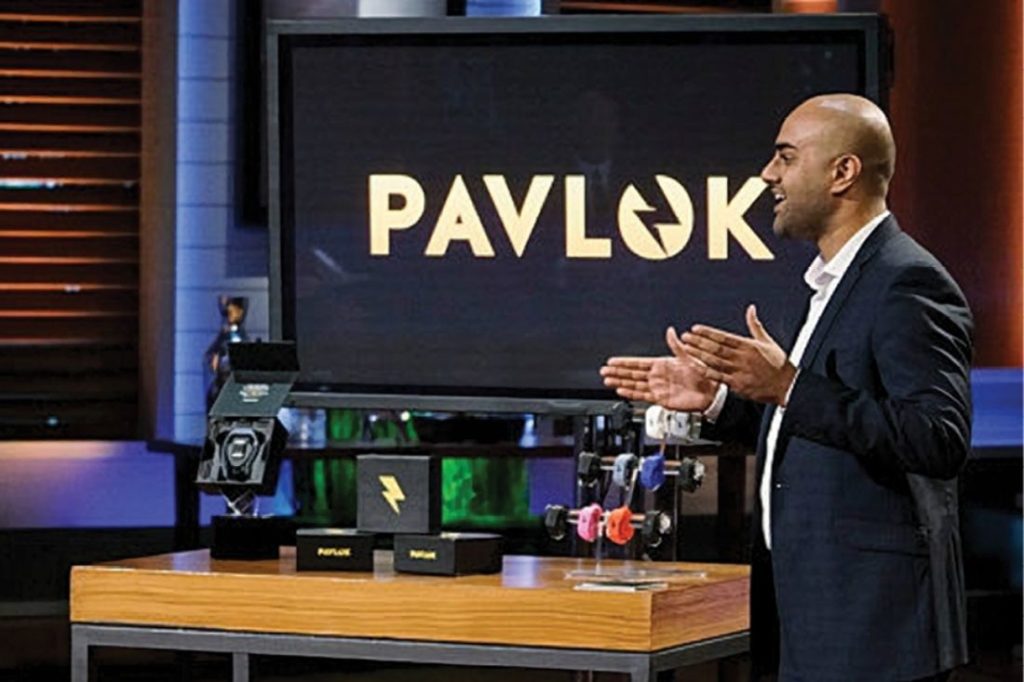During the course of doing this story, I’ve found that there are two types of reactions when people first hear about Pavlok.
Some people are inspired, excited, and ready to try it. Others are repulsed by what they consider a torture device. If you’ve never heard of Pavlok, here goes: It’s a wearable wristband that delivers not-quite-as-mild-as-I-assumed jolts of electricity when you indulge a bad habit. You might be shocked to hear that Pavlok can shock you, for example, if you curse. Or bite your nails. Or procrastinate even when you know you shouldn’t. If it’s a habit you don’t like about yourself, all you’ve got to do is press a button and let Pavlok’s volts—up to 340 of them—trigger immediate regret.
Yes, really.
If you’re in the inspired-excited-ready group, you might also come away impressed by Pavlok’s creator, Maneesh Sethi. You’ll hear his stories of using “aversion therapy” to improve his own life and the lives of thousands of others, and you’ll want to join that group. You’ll even see his public embarrassment on Shark Tank as a story of a person going through a difficult time and coming out the other side stronger.
The torture device camp may see Maneesh Sethi as misguided, arrogant or weirdly sadistic. You might see him as the Shark Tank hosts saw him. Mark Cuban called him a “con man.” Kevin “Mr. Wonderful” O’Leary went with “—hole.” Maybe you’ll agree.
This is a story about a person, a problem, and a product. If all goes according to Sethi’s plans, the product will take care of the problem and make him famous for all the right reasons.
The Person
Sethi is a Tim Ferriss disciple through-and-through. The Stanford student didn’t just read The 4-Hour Workweek and change the way he organized his email inbox; he read it and three days later booked a ticket to Buenos Aires. He traveled the globe working only four hours a week from his laptop for many years. You can still see a video on YouTube from his life as a digital nomad.
The video is equal parts insufferable and inspiring. A 22-year-old Sethi explains how he lives the lifestyle he wants with just a few pairs of pants, three shirts (two of which are the same “because I look damn good in them”), and a Baby Taylor guitar (“mostly for picking up girls”). In the course of his travels his eyes were opened to the power of technology, which caused him to create a nonprofit to provide laptops and internet access to children in a poor village in India.
After moving back to the U.S., he started a blog called Hack the System, for which he experimented with self-improvement techniques, just like Ferriss. He was part of the marketing team for Ferriss’ Four Hour Chef book. But even with a dedication to hacking the body’s programming and becoming the most productive person he could be, he still had serious issues with procrastination and focus.
The Problem
Sethi says he dealt with ADHD his whole life, which would cost him valuable time as he struggled to concentrate on things that mattered. Despite studying under habit expert BJ Fogg at Stanford and having a blog that focused on productivity hacks, he lacked that one specific piece of motivation that could get him to be more productive. So for his blog, he decided to try out an experiment to get himself more focused. It’s a window into Sethi’s mindset.
“I hired a girl, and her job was to follow me around,” he says. “Whenever I wasted time, she would slap me in the face. It was pretty funny, but what was really interesting was that it really made me more productive. I wrote more content in four days than I typically would write in four months.”
The blog post went viral and got the wheels turning in his mind. He and his friend then got the idea to take a shock collar, exactly the kind a desperate dog owner might inflict on a wayward pooch, and hook it up to a computer to zap someone whenever they got on Facebook. The idea may have seemed silly at first, but Sethi says it was a lightbulb moment for him.
“There’s a million wearables that track what you do, but this one is actually changing what you do,” Sethi remembers thinking. “Maybe there’s something more than a funny blog post; maybe this is something that really helps people.”
The Product
Pavlok’s main feature is the “snap” functionality. (That’s what they call the electrical impulses delivered after a negative habit: snaps, not to be confused with zaps.) It’s dependent on you to call your own foul when you commit a bad habit. If you press the button, it gives you a shock. This snap is designed to train your brain to associate bad habits with physical discomfort.
The idea is all about aversion therapy. Instead of triggering the reward center of your brain when you light up that cigarette, Pavlok triggers the pain center of your brain. Sethi is a big believer in aversion therapy, but he says the most important part of Pavlok isn’t the snap itself; it’s knowing that there is a consequence for your actions.
“It’s not the threat of the zap that motivates me; it’s the accountability,” Sethi says. That accountability comes in the form of the community on the Pavlok app where users can discuss their journeys with habit breaking and good-habit forming. Sethi’s goals for Pavlok go well beyond your wrist, he sees it as a community of people working together to improve their lives.
But aversion therapy is not without its critics. Stanford professor and habit expert Russell Poldrack, author of the upcoming book Hard to Break: Why Our Brains Make Habits Stick, says that aversion therapy isn’t a universal solution.
“While there are a number of papers claiming that aversion therapies work, meta-analyses of all the studies out there that I’ve seen are not particularly positive,” Poldrack says. “However, it may well be that some people respond better to that kind of therapy than others.”
Essentially, it depends on the type of person you are. Sethi obviously responds to this kind of negative feedback, but others—like me, it turns out—don’t react as positively. You could say Sethi is a glutton for punishment. But even he didn’t enjoy his experience on Shark Tank.
The Person
Maneesh Sethi—whose brother is author and personal finance guru Ramit Sethi—went on the show, like every other entrepreneur, hoping his pitch would trigger a bidding war between the sharks. That’s not what happened. Robert Herjavec was interested, but was quickly convinced by Cuban’s insistence about Maneesh Sethi’s “nonsense” research.
Finally, O’Leary was the only shark left. (The March/April 2021 cover figure, Daymond John, was not allowed by producers to be on Sethi’s episode because the two previously knew one another.)
Unbeknownst to O’Leary, Sethi had decided before he appeared on the show that he wouldn’t accept a deal with him. He told me it was because of previous statement O’Leary had made that rubbed Sethi the wrong way. Though O’Leary offered Sethi a deal, he turned it down with a shocking statement: “I would take an offer from anybody besides Mr. Wonderful.”
O’Leary was enraged and told Sethi to “get the —- out.” It was one of the most memorable and stunning Shark Tank episodes of all time. Sethi walked away empty-handed and into infamy.
Within a day of the episode airing, he says they had 39 fake 1-star reviews on Amazon. His dream had become a nightmare. Pavlok was no longer a cool startup wearable company; it was the company that got ripped apart on Shark Tank. Most entrepreneurs might have looked to get as far away from this brand as possible.
That was five years ago. Pavlok has since sold over 100,000 units. The Pavlok 3 and Shock Clock 2, much-improved versions of the original devices, were released in late 2020. A recent crowdfunding campaign raised more than $250,000 and was backed by north of 2,000 people. The brand is stronger than ever.
Sethi and the Pavlok team came out of the Shark Tank more focused on making the best possible products to tackle bad habits. Might it be fair to say, then, that this episode was a very public example of the potential power of aversion therapy?
The Problem
Habits are actually a good thing. The fact that your brain can set certain regular activities on autopilot is vital to daily life.
“Without habits, we’d be screwed,” Poldrack says. “Habits are our brain’s way of figuring out what’s constant in the world and not making us think about that.”
But it’s when that part of the brain goes sideways, for very serious reasons like drug addiction or less explainable ones like teeth grinding, that problems arise. It can be extremely difficult to break those habits, even ones that don’t involve chemical dependencies. Every human being has tried to stop bad habits and start good ones, to varying levels of success.
Some people are incredibly effective at this. But Poldrack says that despite years of study, it’s unknown what exactly makes one person able to stop bad habits more easily than others. It’s certainly not the widely accepted “willpower” reasoning.
“If you look at the willpower of someone who is trying to get drugs for example, they are very strong-willed when they are doing that. It’s not as if they don’t have power of will,” Poldrack says.
He went on to explain that in a drug-addicted person, the brain’s habit system is being hijacked by the drugs, which makes that desire stronger than their willingness to quit.
“Obviously some people are able to do it,”Poldrack says. “But I haven’t seen compelling scientific research that tells us why exactly one person is able to quit and one person isn’t.”
This humanity-wide problem is one of the reasons that Sethi’s company has survived despite his Shark Tank experience. Bad habits are everywhere. Even the most disciplined person you know could tick off a list of things they’d like to stop doing.
So, without specific scientific research that explains why certain people can stop bad habits more effectively than others, the market for products and courses and methods to stop these habits remains strong. Some people are willing to try anything to stop, even inflicting physical pain on themselves.
The Product
I’ll admit, I wasn’t super excited to start using the Pavlok 3. For one, I couldn’t figure out where to start with my bad habits.
Do I use it to stop touching my face? Or what about as an alarm clock? Or to stop slouching? Oh, I know. I should use it to stop me from wasting so much time on Twitter. No, I need it to make me stop my little outbursts of anger.
I’ve got some issues.
Fortunately, the Pavlok comes with a course to take to help you identify which issues you really want to address; it involves some meditation and mindfulness exercises led by Sethi. While doing the exercises, I realized how much valuable time I was wasting on social media. I knew that I needed to focus on this habit. So whenever I found myself opening up that extra tab for Twitter or grabbing my phone for a peek at Instagram, I pressed the button on the Pavlok 3.
Don’t let the playful word snap distract you from the fact that this thing is designed to give you an electric shock. I know you are wondering, so here goes: It freaking hurts.
The pain initially happens in your wrist but immediately can be felt in your brain—specifically for me, in the front part of my brain. Sometimes it would even make me a little hot for a brief second. And then after that brief second of pain, it all goes away. And it makes you want to stop doing whatever you just did to cause that pain. In short: it works exactly the way it was intended.
The Point
The truth of the matter is, I’m not the target audience for this device. I didn’t have a burning desire to stop doing one of those annoying habits, even if I know deep down that it would be better for me. You can’t passively rewire your brain; it requires significant, dedicated effort. If you’re reading this story and are ready to order a Pavlok, it’s because you are thinking of one specific habit that you have tried to stop for years. You’ve reached the end of your rope and are ready to step up to using this device.
While I can’t brag about serious leaps in productivity (a bout with COVID during this trial period didn’t help), I can say the Pavlok made me much more aware of myself. It got me out of autopilot and showed me ways I was letting behaviors control my life. Sethi says this awareness is one of the most important lessons to learn from Pavlok, even if the shock part isn’t your cup of tea. Poldrack, though he has never used the product, agrees that this is an important benefit.
“An important part of change is just becoming aware of the habit,” Poldrack says.
When you’re aware of your bad habit, there are of course other routes you can take to stop it than shocking yourself. I’ve installed a blocker on my computer that limits when I can access certain websites. It doesn’t inflict physical pain on me and it still gets the job done.
The truth is, I installed this tool years ago, only to forget about it until I started using the Pavlok. The awareness that I gained in reporting this story allowed me to rethink and refocus my self-improvement efforts.
We all have bad habits. The most important thing is being aware of them and figuring out the best ways to change your behaviors.
Or else.
This article originally appeared in the March/April 2021 issue of SUCCESS magazine.
Photo courtesy of Pavlok










